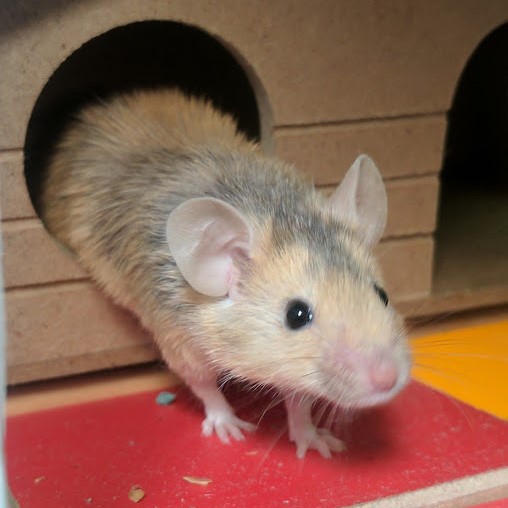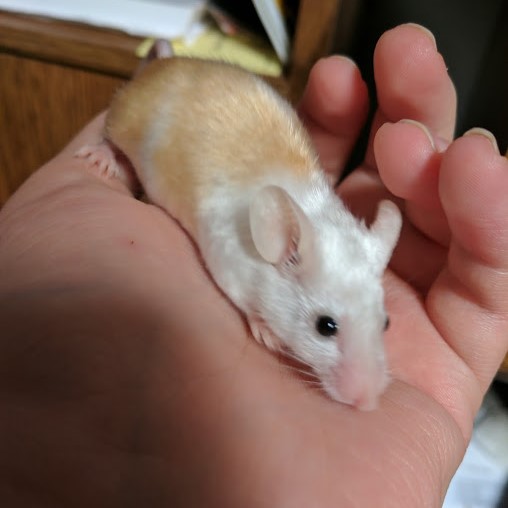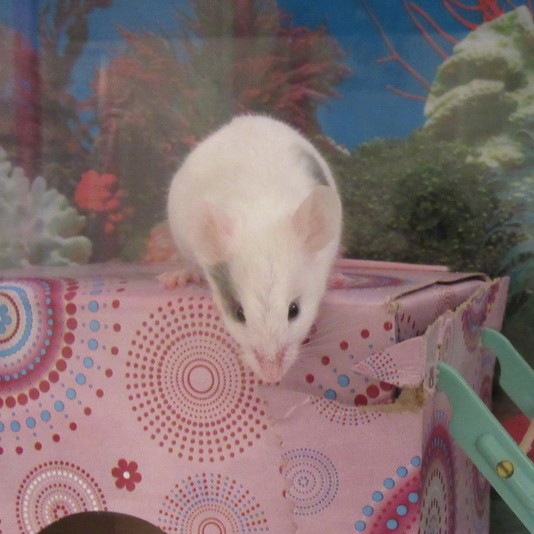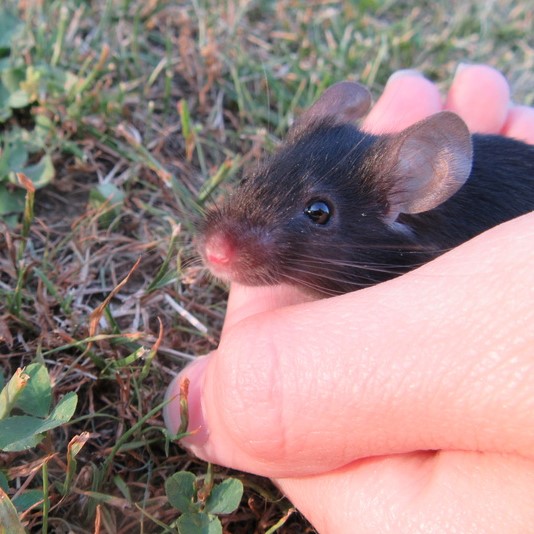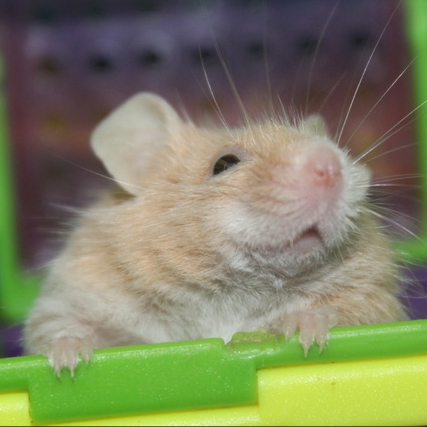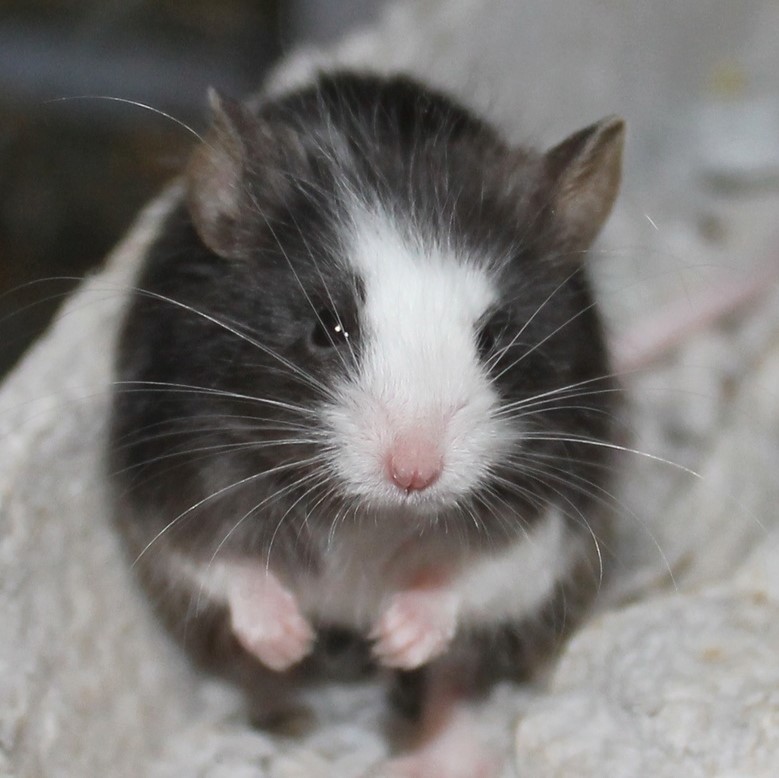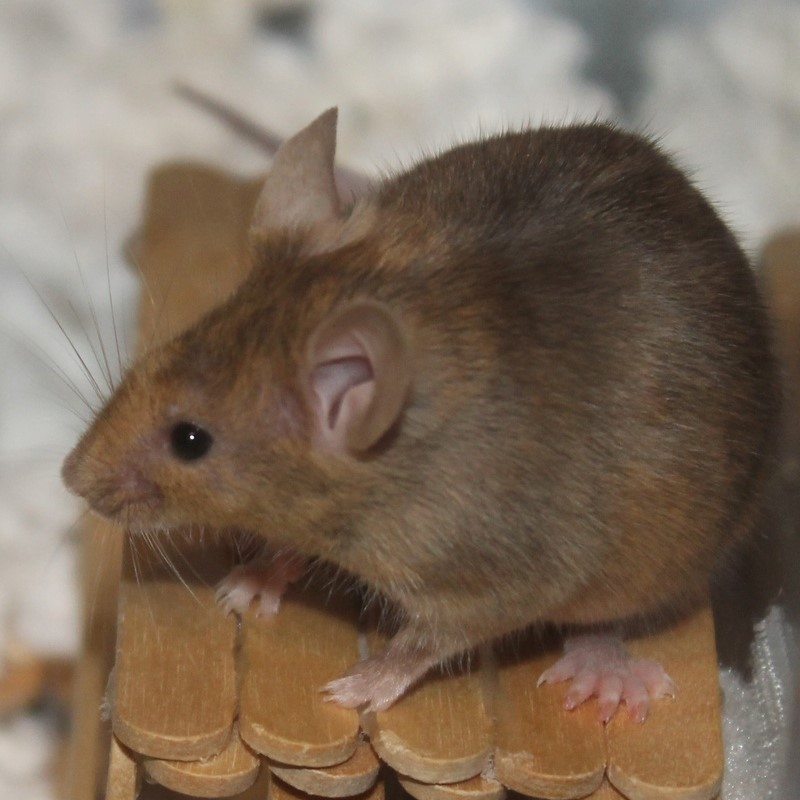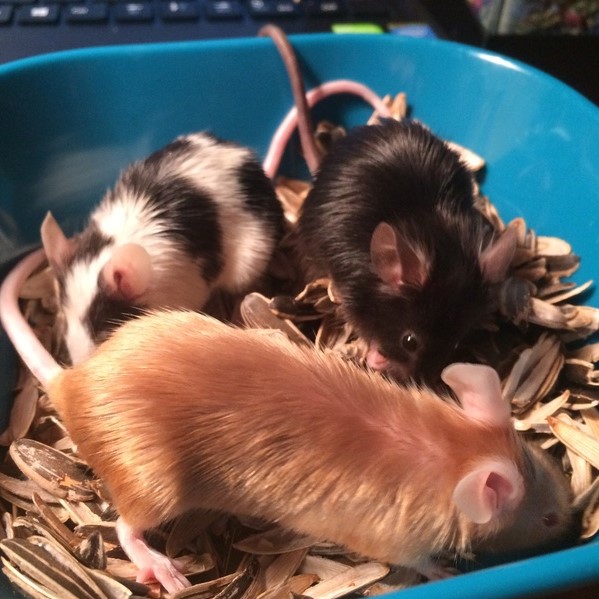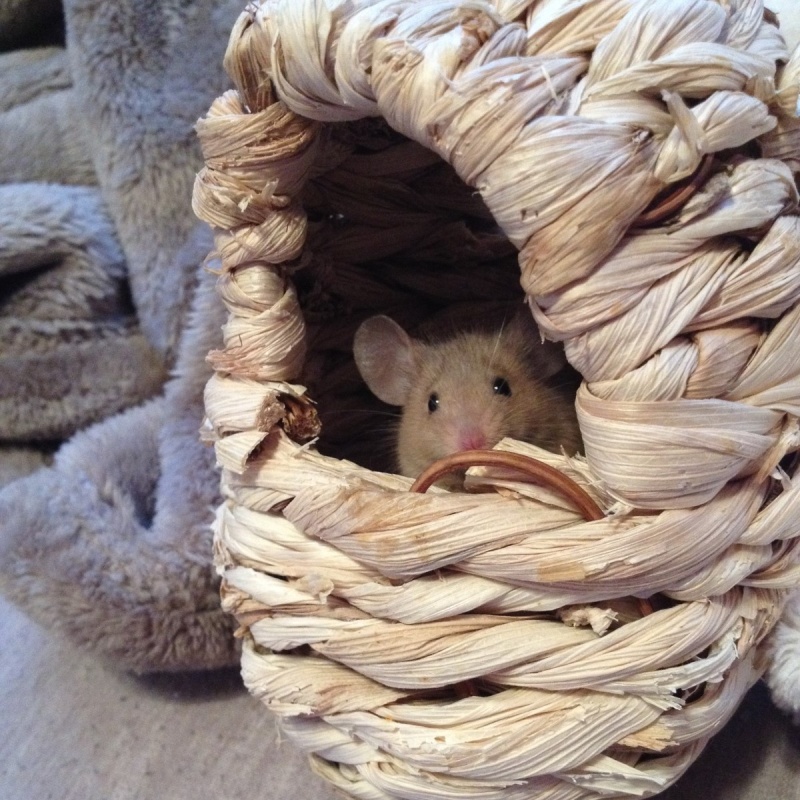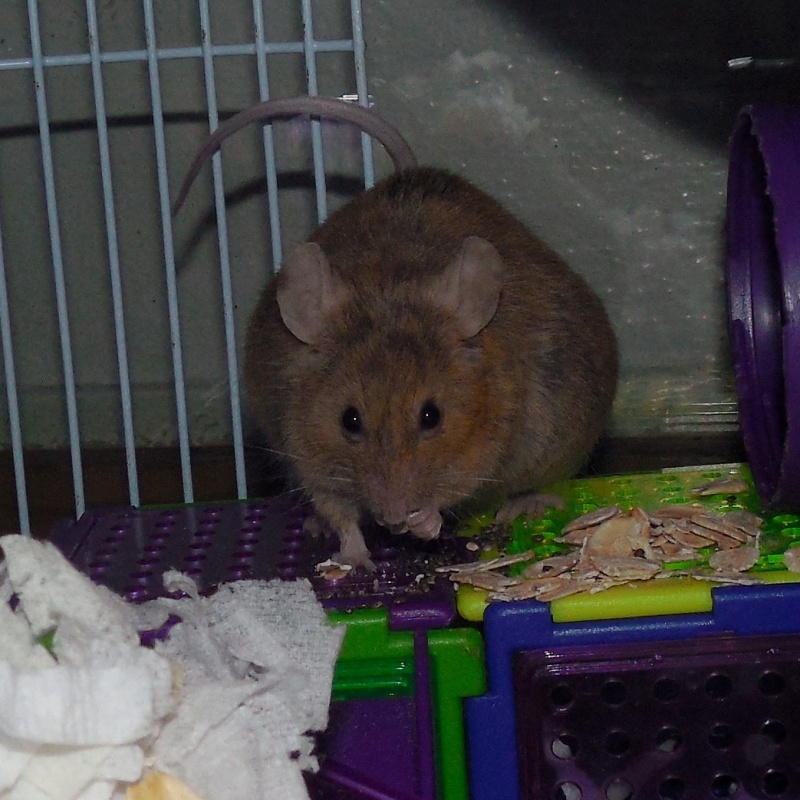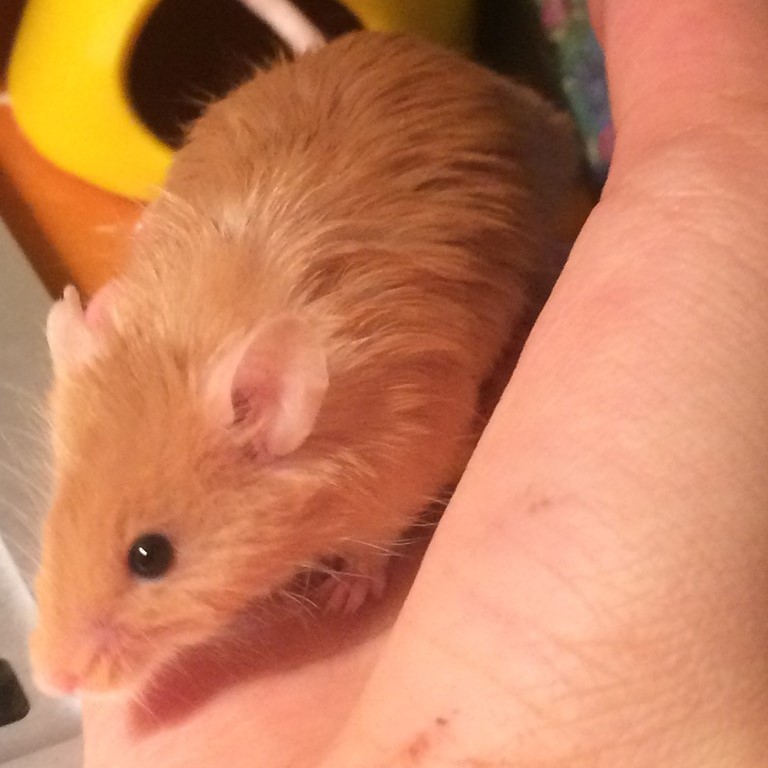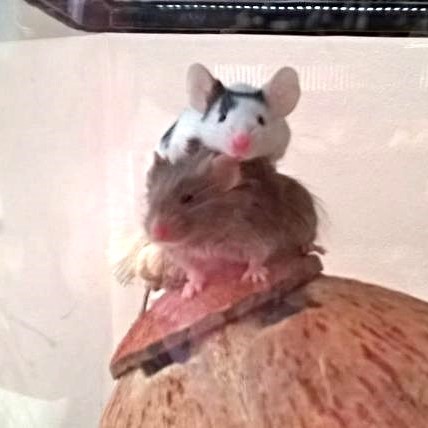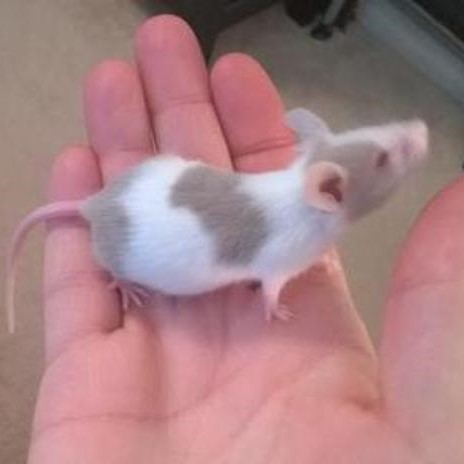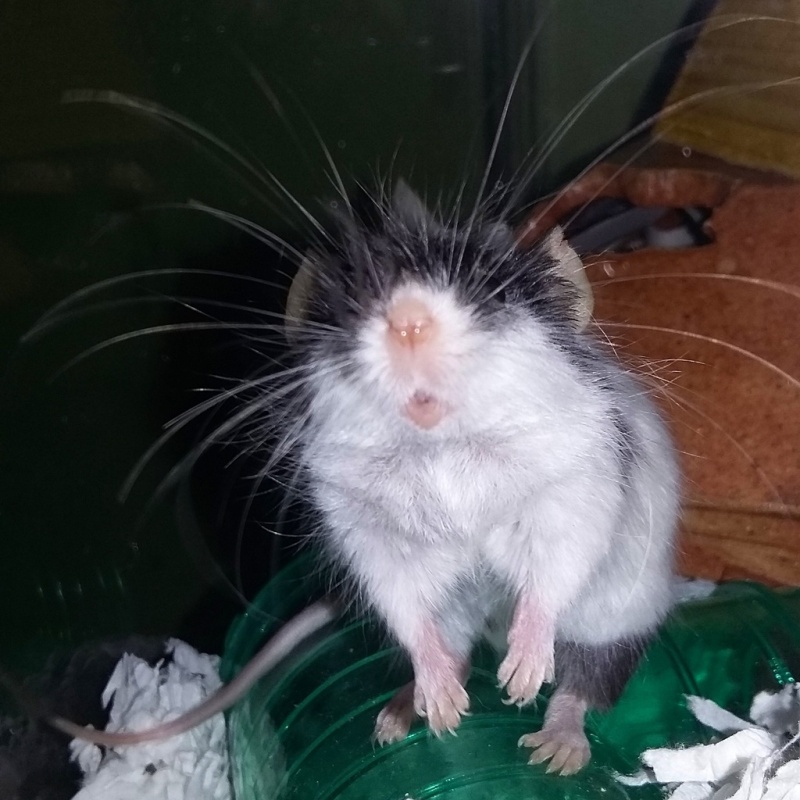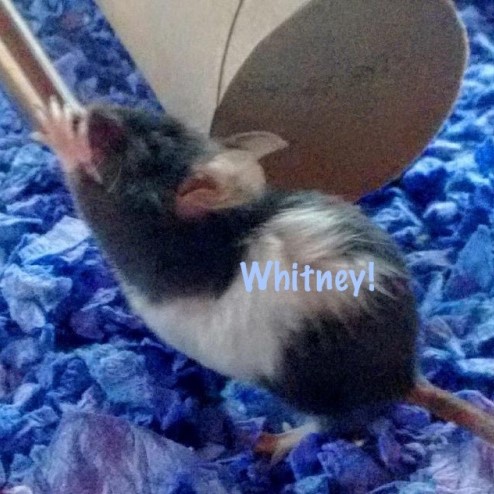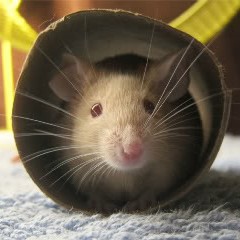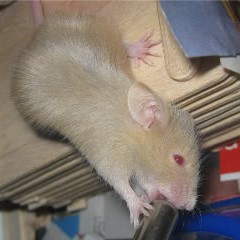Mouse Genetics
Page 1 of 1
 Mouse Genetics
Mouse Genetics
Terms
I tried to use the simplest definitions and examples in an effort to make it easier for new fanciers. There is always room to learn more about the definition of each term. This will give you a great jump start into the terms often used with mouse genetics. All terms are described in relation to mice.- Variety: A variety is a show term or descriptive term used in describing the appearance of a mouse.
Blue, Rex, Siamese, etc are all varieties. - Genetics: The study of heredity.
- Inheritance: Inheritance is how genes are given from parent to offspring.
Each parent gives his or her offspring one allele on each locus, making up the baby's genotype. - Chromosome: A chromosome is a thread of DNA. A mouse has 20 chromosome pairs, making 40 chromosomes total. Each parent contributes one set of chromosomes to their offspring.
The "A" locus is on chromosome two in a string of DNA; it will contain one chromosome from the mother, such as A, and one from the father, such as Ay. - Gene: A gene occupies a specific place on a chromosome.
Ay, Avy, Aw, A, at, a, and ae are all different forms of the same gene. - Locus (ˈlō-kəs, noun. Singular: Loci, lō-ˌsī): A locus is the position a gene is on a chromosome.
"A" Agouti is on the A locus which is located on chromosome 2. - Allele (ə-ˈlēl, noun): An allele is a form of a gene. Mice have two alleles per locus.
Ay, Avy, Aw, A, at, a, and ae are all different alleles. - Modifier: A modifier is a nonallelic gene that alters another gene.
- Genetic code: A genetic code is a sequence of code which describes DNA.
- Homozygous (hō′mō-zī′gŭs, adj.): Homozygous means that a mouse has identical alleles on a specific locus.
Homozygous agouti would carry both A alleles: A/A. - Heterozygous (het′ĕr-ō-zī′gŭs, adj.): Having different alleles on a specific locus.
Heterozygous agouti would carry only one agouti allele A and a different allele on that locus: A/a (just to give one of many combinations). - Dominant: A dominant allele is one that expresses itself over a recessive allele. A dominant trait will appear in offspring if only one parent contributes the dominant gene.
Agouti A is dominant over non-agouti a making the mouse appear to be agouti. - Co-dominant: Co-dominant is when two dominant alleles can be expressed at the same time.
- Incomplete Dominance/Semi-dominant: A heterozygous form where both alleles are partially expressed, producing an intermediate phenotype.
ce/ch Color Point Beige is an example of two semi-dominant alleles. ce/ce makes a coffee phenotype and ch/ch makes a siamese phenotype (on a black mouse). When ce and ch are combined, the heterozygous form is in between that of the homozygous form of the alleles. - Recessive: A recessive gene is one that doesn't show unless it is paired with another recessive gene. Both parents have to contribute the recessive gene in order for it to show in the offspring.
In order for a mouse to be extreme non-agouti ae/ae each parent must contribute one recessive ae allele. - Genotype (jē-nə-ˌtīp, noun): A genotype refers to the genetic makeup of a mouse.
The genotype of my Standard Blue Agouti mouse is A/a B/B C/c d/d Fr/fr Fz/Fz E/e Go/go Hr/Hr. (Note: All genes can be included, however in an effort to make it shorter I tried to limit it.) - Phenotype (fē-nə-ˌtīp, noun): A phenotype is how the animal displays its genotype - that is, how it appears.
Using the genetic code of the mouse above (genotype example), the mouse's phenotype is Standard Blue Agouti. - Mendelian inheritance (men-ˈdē-lē-ən, noun): Mendelian inheritance refers to a theory of genetic laws of inheritance set forth by Gregor Mendel.
- Punnett Square (pə-nət-, noun): A Punnett Square shows how alleles are inherited from parent to offspring, showing you the genotype of what the offspring of two mice will give based on Mendelian genetics. Examples of punnett squares are shown below.
(Named after Reginald C. Punnett 1967 English genetics) - Epistatic (e-pə-ˈsta-tik, adj): The suppression of a nonallelic gene.
Albino is epistatic to Lethal Yellow. - Hypostatic (hī-pə-ˈsta-tik, adj): The failure of a gene to produce its usual effect when coupled with another nonallelic gene that is epistatic toward it.
Lethal Yellow is hypostatic to Albino.
Mouse Genes and Alleles
All alleles on each locus are listed in order of dominance.A Chromosome 2
- Ay - Yellow
- Avy - Viable Yellow
- Aw - White Belly Agouti
- A - Agouti
- at - Tan
- am - Mottled Agouti
- a - Non-agouti
- ae - Extreme non-agouti
B Chromosome 4
- B - Full Color
- bc - Cordovan
- b - Brown (Chocolate)
bt Chromosome 15
- Bt - Not Belted
- bt - Belted
C Chromosome 7
- C - Full Color
- cch - Chinchilla
- ce - Extreme Dilution
- ch - Himalayan
- c - Albino
Ca Chromosome 15
- Ca - Caracul
- ca - Standard (not Caracul)
D Chromosome 9
- D - Full Color
- d - Blue
E Chromosome 8
- E - Full Color
- e - Recessive Yellow
fr Chromosome 7
- Fr - Standard (not frizzy)
- fr - Frizzy
fz Chromosome 1
- Fz - Standard (not fuzzy)
- fz - Fuzzy
go Chromosome 5
- Go - Standard (not angora)
- go - Angora
hr Chromosome 14
- Hr - Standard (not hairless)
- hr - Hairless
hs Chromosome ?
- Hs - no head spot
- hs - Head Spot
lgh Chromosome 8
- Lgh - Standard (not long hair)
- lgh - Long Hair
ln Chromosome 1
- Ln - Full Color
- ln - Leaden (aka Mock Blue)
Mo Chromosome X (sex linked)
- Moto - Tortoiseshell
- Mobr - Brindled
- mo - No Brindling
P Chromosome 7
- P - Full Color
- p - Pink eye dilution
Re Chromosome 11
- Re - Rex
- re - Standard (not rex)
Rn Chromosome 14
- Rn - Roan
- rn - Not Roan
rst Chromosome ?
- Rst - Standard (not rosette)
- rst - Rosette
ru Chromosome 7
- Ru - Not Ruby eyes
- ru - Ruby eyes
Rw Chromosome 5
- Rw - Rump White
- rw - Not Rump White
S Chromosome 14
- S - No Spots (aka Self)
- s - Piebald
sa Chromosome 13
- Sa - Standard
- sa - Satin
si Chromosome 10
- Si - No silvering
- si - Silver Ticking (silvered)
T Chromosome 17
- T - Brachyury (Short Tail)
- t - Brachyury interacting tail length modifier
*note that there are a lot of tail modifiers.
U Chromosome ?
- U - Umbrous (*I am not positive that this is dominant to Up)
- Up - Umbrous Patterned
- u - Not Umbrous
W Chromosome 5
- W - Variegated
- Wsh - Sashed
- Wbd - Banded
- w - Not marked on this locus
Inheritance, Punnett squares, Single Locus
In order to understand this section you will need an understanding of basic genetic terms, what alleles are dominant over others, what genes are epistatic to others (the Genes page can help with this), etc. In order to apply what is taught here into your breedings, you need to understand what genotypes your mice are. Punnett Squares are only as accurate as the information you put into them.Each baby inherits one allele on each locus from each parent. Below I will explain how to make a punnett square, which will aid you in determining what alleles a given litter will inherit from their parents, making all possible genotypes for a given locus. This punnett square only covers one locus. Following chapters will cover more than one.
For the sake of example, I'm going to do a punnett square for a Heterozygous Agouti Father A/a and a Heterozygous Lethal Yellow Mother Ay/a.
To make a punnett square for one locus you need to draw a table that has 3 rows and 3 columns. The top left square is always left blank.
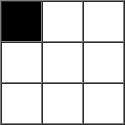
Next fill in the alleles for each parent. In the top row add both alleles, one per square, for the father (shown in the blue squares). On the left side column add both alleles, one per square, for the mother (shown in the pink squares). When listing the alleles, make sure that you place the dominant allele first. In the case of both alleles being dominant, add the one that is dominant over the other first.
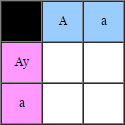
Next we start filling in the middle squares which will determine what combinations of alleles the offspring can inherit for that locus. Start with the first open square. To do this with the most accuracy, you should always add the more dominant allele first. For the first square you take the Ay from the mother (directly to the left of the purple square you are filling in) and the A from the father (directly above the square you are filling in) and add them to that first open square, as shown below.
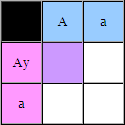
You will fill in each additional square the same as you did the first. Take an allele from each father and mother to fill in the corresponding square.
To fill in the second square, take the Ay from the mother and the a from the father.

Second row, first square; fill in the A from the father and the a from the mother.

Last square; fill in the a from the mother and the a from the father.
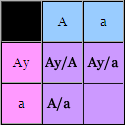
Here we can see all of the possible combinations of alleles the babies can inherit. There are 4 possible combinations of alleles that the litter can inherit on that locus. Basing it on the laws of statistics, Each square accounts for 25% of your litter. You should get 25% of each Ay/A, Ay/a, A/a, and a/a.
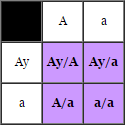
Now that you know what combinations of alleles the offspring can inherit on that locus, you can p
artially determine what the babies will look like (phenotype). Statistically you get: 25% Agouti (A/a genotype). 25% Non-Agouti (a/a genotype). 50% Lethal yellow (both Ay/a and Ay/A genotypes will give you Lethal Yellow Phenotype because Lethal yellow is epistatic to Agouti). Note that when you factor in other alleles on other loci, the phenotype may be significantly different than what you see when only factoring in only one locus.
Inheritance, Punnett squares, 2 Loci.
This section will show you how to determine all possible combinations of alleles offspring can inherit on 2 given loci. In order to understand this section, you must have a full understanding of the last section.For the sake of example, I will do these punnett squares for a Blue father with B/b d/d genotype (blue carrying chocolate) and a Black mother with B/b D/d genotype (carrying both chocolate and blue).
As shown on the last page of this section, you need to make a punnett square for each locus. Like before, put the fathers alleles for the B locus on the top row and the mothers alleles for the same locus on the side column to complete your punnett square for that locus. Do the same for the D locus in the other punnett square. This will show you what possible combinations offspring can inherit on those 2 loci individually.
Completed punnett squares for each locus:

Next you will make a larger punnett square to include both loci which will help you determine the combinations of both loci together. This table will consist of 5 rows and 5 columns as shown below. Using the completed squares from above, take the 4 combinations of alleles the babies can inherit on the B locus (in purple) and add them to the left column in the following punnett square. Then add the D locus (in green) to the top row.

Next you will fill in the alleles from the B locus and the D locus to determine all possible genotypes for those loci that the offspring can inherit. You will fill them in similar to how you did the punnett square for a single locus, taking a set from the left column and a set from the top row to fill in each corresponding square.
Animated example of how to fill in the squares:

Completed punnett square:

You will notice from above that there are 16 squares of genotypes that the babies can inherit. This means that each square accounts for 6.25% of the litter (100 ÷ 16 = 6.25).
Now it's time to start figuring out what percent of the litter will have a specific genotype as some squares will be repetitive.

The table above is color coded to easily show all genotypes that are the same.
Each square accounts for 6.25% as stated before. To figure out what percent of a litter should inherit each genotype you will multiply each corresponding genotype (shown in the same colored squares) by the number of squares that genotype occupies. Example: In the case of the green squares (shown above) with B/b D/d genotype, we multiply:
6.25% the percent each square accounts for in the litter.
×4 the number of squares that same genotype occupies.
----------
25% that will have B/b D/d genotype.
Do that for all possible genotypes. The table below is a completed list of possible genotypes and percents for that genotype based on the punnett square above.

Knowing all possible genotypes is just as important as knowing all possible phenotypes (explained below). This will help you with future breedings and knowing the chance that the babies have of carrying something recessive or hidden.
Now it's time to start figuring out what percent of the litter will have a specific phenotype based on genotype. I took the genotype table from above and added what phenotypes they are in the table below. As you can see, some genotypes can make the same phenotype.

Using the numbers above, you can calculate what percentage of each litter that will have each of those phenotypes. To do this, add all corresponding phenotype percentages together, as shown below:

The percentages for each phenotype for this litter will be; 37.5% Black, 37.5% Blue, 12.5% Chocolate, and 12.5% US Dove, as shown in the table above.
Always remember, what nature has planned isn't always what statistics will tell you. You may get more or less of one genotype than what the statistics say. In addition, smaller litters can not possibly pull out all possible genotypes (if you have 16 different genotypes and 5 babies, it's not possible to get all possible genotypes in a litter).
Understanding Colour
In making this page, I tried to simplify everything in an effort to make it easier for the new fancier. There is always room to learn more, a lot more. Genetics is an ever evolving field. This section will hopefully give you a great jump start in understanding the colors and markings of mice. To fully understand this section you must have a basic understanding of genetic Terms.
Understanding mouse genetics isn't about simply knowing what genotype produces a certain phenotype, such as; at/a* p/p is Lilac Tan. Truly understanding mouse genetics entails knowing why and how a genotype produces a specific phenotype. Once you have a basic understanding of this, genetics and breeding will become much easier to interpret. Within reason, you will be able to figure out genotypes that you have never seen before simply by applying what you know about how colors work.


Pink Eye Dilute p/p is on the P locus on chromosome 7. This dilute not only affects eye color but it also affects coat color. Pink Eye Dilute affects Black pigment drastically, while it has minimal affect on Yellow. When homozygous for Pink Eye Dilute, a Black Tan mouse will be diluted to a Lilac Tan at/a* p/p, shown here on the right. As you can see, the Pink Eye Dilute has diluted the black hairs of the mouse dramatically while leaving the yellow hairs nearly untouched.

It is important to note that there are many different alleles found on the c-locus (chromosome 7) that we have in the fancy. Most of these other alleles have a stronger effect on both black and yellow than the Chinchilla Dilute, yet the principles are the same. They all have a stronger effect on Yellow pigment than Black. Look forward to a future C-dilute genetics section which will illustrate this. Also look forward to the Agouti Locus which will explain more on color distribution.

AppleCheeks- Sr Member

- Join date : 2016-04-03
Posts : 123
 Similar topics
Similar topics» Healthy, young mouse continually losing weight [Deer Mouse]
» progress of young found house mouse (wild mouse)
» Suddenly find myself a mouse owner after a wild house mouse came to me for help
» Hey! I a mouse owner of one male mouse named Mickey :)
» Introducing female deer mouse to orphaned mouse
» progress of young found house mouse (wild mouse)
» Suddenly find myself a mouse owner after a wild house mouse came to me for help
» Hey! I a mouse owner of one male mouse named Mickey :)
» Introducing female deer mouse to orphaned mouse
Page 1 of 1
Permissions in this forum:
You cannot reply to topics in this forum|
|
|











